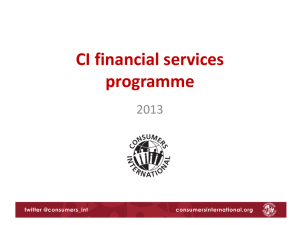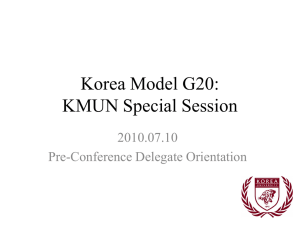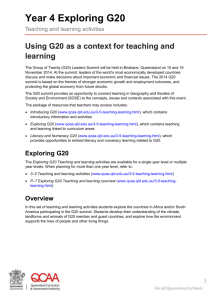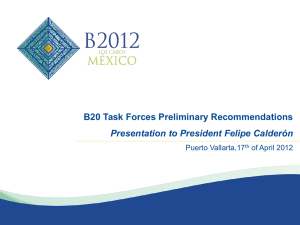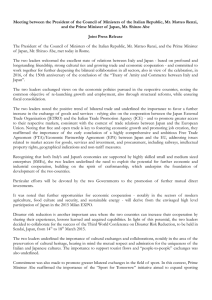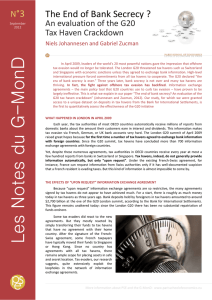Year 5 Exploring G20 - Queensland Curriculum and Assessment
advertisement
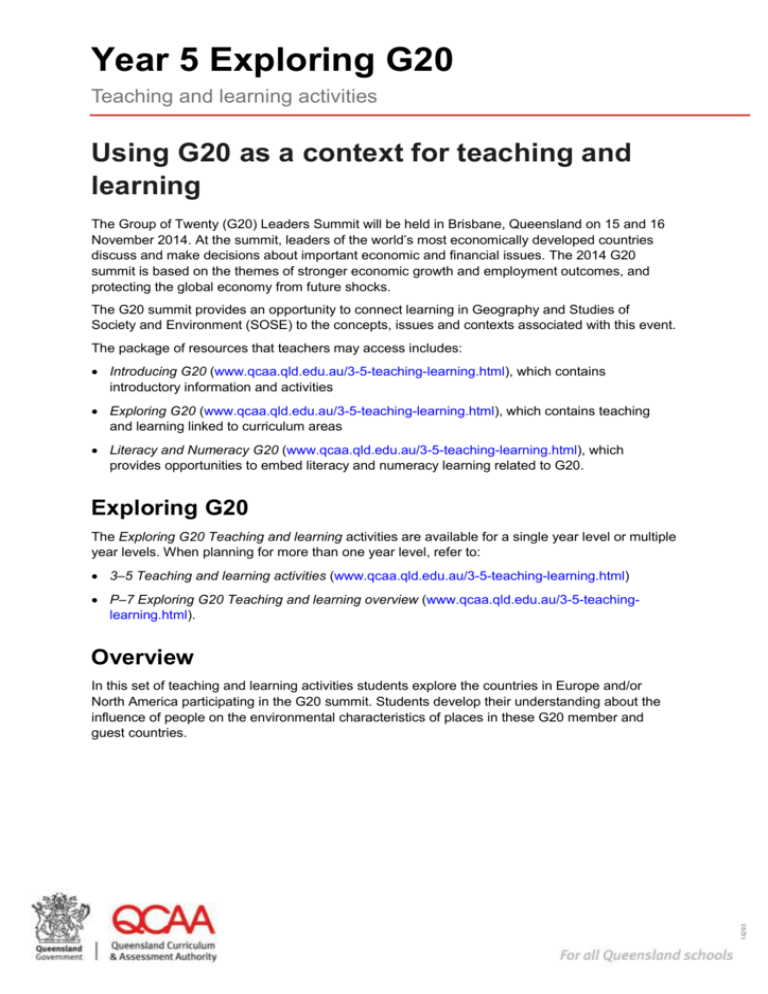
Year 5 Exploring G20 Teaching and learning activities Using G20 as a context for teaching and learning The Group of Twenty (G20) Leaders Summit will be held in Brisbane, Queensland on 15 and 16 November 2014. At the summit, leaders of the world’s most economically developed countries discuss and make decisions about important economic and financial issues. The 2014 G20 summit is based on the themes of stronger economic growth and employment outcomes, and protecting the global economy from future shocks. The G20 summit provides an opportunity to connect learning in Geography and Studies of Society and Environment (SOSE) to the concepts, issues and contexts associated with this event. The package of resources that teachers may access includes: Introducing G20 (www.qcaa.qld.edu.au/3-5-teaching-learning.html), which contains introductory information and activities Exploring G20 (www.qcaa.qld.edu.au/3-5-teaching-learning.html), which contains teaching and learning linked to curriculum areas Literacy and Numeracy G20 (www.qcaa.qld.edu.au/3-5-teaching-learning.html), which provides opportunities to embed literacy and numeracy learning related to G20. Exploring G20 The Exploring G20 Teaching and learning activities are available for a single year level or multiple year levels. When planning for more than one year level, refer to: 3–5 Teaching and learning activities (www.qcaa.qld.edu.au/3-5-teaching-learning.html) P–7 Exploring G20 Teaching and learning overview (www.qcaa.qld.edu.au/3-5-teachinglearning.html). Overview 14293 In this set of teaching and learning activities students explore the countries in Europe and/or North America participating in the G20 summit. Students develop their understanding about the influence of people on the environmental characteristics of places in these G20 member and guest countries. Curriculum links The Year 5 Exploring G20 Teaching and learning package provides opportunities for students to demonstrate the following curriculum content. Australian Curriculum: Geography Key inquiry question: How do people and environments influence one another? Year 5 Geographical Knowledge and Understanding Geographical Inquiry and Skills The location of the major countries of Europe and North America in relation to Australia and the influence of people on the environmental characteristics of places in at least two countries from both continents (ACHGK026) Collect and record relevant geographical data and information, using ethical protocols, from primary and secondary sources, for example, people, maps, plans, photographs, satellite images, statistical sources and reports (ACHGS034) The influence of people, including Aboriginal and Torres Strait Islander Peoples, on the environmental characteristics of Australian places (ACHGK027) Present findings and ideas in a range of communication forms, for example, written, oral, graphic, tabular, visual and maps; using geographical terminology and digital technologies as appropriate (ACHGS038) Opportunities to embed the general capabilities and cross-curriculum priorities in the classroom are identified using the following icons related to each content description. Aboriginal and Torres Strait Islander histories and cultures ICT capability Critical and creative thinking Sustainability Intercultural understanding Literacy Numeracy Ethical behaviour Queensland curriculum: Studies of Society and Environment Essential Learnings By the end of Year 5 Place and Space Global environments are defined by features, including landforms, location markers (Tropics of Cancer and Capricorn, and the Equator), countries, regions, continents, and climatic zones Year 5 Exploring G20 Teaching and learning activities Queensland Curriculum & Assessment Authority July 2014 Page 2 of 5 Assessment The following assessment ideas could be included in a folio of student work. Teachers will make decisions about the specific assessment techniques, formats and categories to be used. Task Explain the characteristics (climate, natural vegetation, animals and landforms) of a G20 country from Europe and/or North America in relation to Australia. Represent characteristics data in a table or on a map using cartographic conventions. Describe the interconnections between people, places and environments. Identify the effect of these interconnections on the characteristics of places and environments. Present findings using geographical terminology in a communication form, e.g. written, spoken/signed and/or multimodal. Students will: explain the characteristics of places in different locations describe the interconnections between people, places and the environment identify the effects of these interconnections on the characteristics of places and environments represent data in a table or on a map using cartographic conventions of border, scale, legend, title and north point present findings using geographical terminology in a communication form. Teaching and learning The following teaching and learning activities are described in a sequence that aims to develop student learning. However, teachers may select activities and plan alternative sequences to suit their local setting. Teaching and learning activities Focus question: How do people influence the environmental characteristics of G20 countries of Europe and/or North America? Activity 1 Using the Interactive G20 map (Basic) (http://g20.qcaa.qld.edu.au), locate: the equator, Tropics of Cancer and Capricorn, and the continents in relation to Australia countries attending the G20 summit countries from the European Union attending the G20 summit G20 countries in Europe and North America in relation to Australia. Activity 2 Explore the environmental characteristics (e.g. climate, natural vegetation and animals) of Brisbane or another place in Queensland. Use geographical tools such as a wall map, atlas or spatial application (e.g. Primary virtual field trip (www.qcaa.qld.edu.au/virtual-fieldtrips.html) or Queensland Globe (www.dnrm.qld.gov.au/mapping-data/queensland-globe)) to complete your research. Collect and record information in a table about climate, natural vegetation and animals. Activity 3 Examine the interconnections between people and the natural vegetation of places in Queensland (e.g. as a result of clearing vegetation and/or planting, urban development, farming and mining) using historical imagery on a spatial application, e.g. Google Earth (www.google.com/earth). If using Google Earth, use the time slider to move between dates and view the changes on vegetation as a result of the influence of people on a place over a set timeframe, e.g. five years since you were born. List the information and discuss the influence of people on the natural vegetation over time. Year 5 Exploring G20 Teaching and learning activities Queensland Curriculum & Assessment Authority July 2014 Page 3 of 5 Activity 4 Explore the environmental characteristics of a G20 member country of Europe and/or North America. Using information on the Interactive G20 map (Basic) (http://g20.qcaa.qld.edu.au) (see Climate and Vegetation zones filters and Environment information) and other sources, collect information about the country, including: climate zones, e.g. tropical, temperate vegetation zones, e.g. grassland, desert animals, e.g. wild boar, cape buffalo. Record information in a table or map using cartographic conventions, including border, source, scale, legend, title and north point. Compare this information to data from Activity 2 about your chosen Queensland location. Use this information to discuss: How is the climate similar or different? How and why is the natural vegetation similar or different? How and why are the animals similar or different? Discuss the possible short-term and long-term effects of introducing vegetation and animals of: a European and/or North American country into Australia Australia into a European and/or North American country. Activity 5 Consider how the environment supports the lives of people and other living things in a Queensland location of your choice and a G20 member country. Discuss: How does the vegetation support the lives of people? How does the vegetation support the lives of other living things? What is the significance of the vegetation to the environment and the people? How have people influenced the environment? Activity 6 Using a spatial application such as the Primary virtual field trip (www.qcaa.qld.edu.au/virtualfield-trips.html), Queensland Globe (www.dnrm.qld.gov.au/mapping-data/queensland-globe) or other sources with historical imagery (e.g. Google Earth (www.google.com/earth)), discuss the effects of people on the environmental characteristics (e.g. climate, natural vegetation and animals) of Brisbane. Discuss: What changes have been made by people in those places over time? How have people changed areas of natural vegetation over time? What effects have these changes had on animals? How are animals being protected from urban development? Year 5 Exploring G20 Teaching and learning activities Queensland Curriculum & Assessment Authority July 2014 Page 4 of 5 Resources Below is a list of resources to support the Exploring G20 Teaching and learning activities. G20 Resources and links Interactive G20 map (http://g20.qcaa.qld.edu.au) An interactive world map providing information (including resources) for teachers and students about the G20 countries. Primary G20 virtual field trip (www.qcaa.qld.edu.au/virtual-field-trips.html) An interactive field trip of the Brisbane G20 precinct. What is the G20? (Dr Matthew Burke) video (www.qcaa.qld.edu.au/expert-videos.html) A short video of G20 expert Dr Matthew Burke introducing the G20 summit. G20 website (www.g20.org) A website about the G20, its members, priorities, past summits, event schedule as well as the Queensland 20 (Q20) and the benefits it presents Queensland’s business, community and government sectors from Australia’s G20 presidency in 2014. Spatial online tools Google Earth (www.google.com/earth) A spatial online tool, which provides up-to-date maps, imagery, and other spatial data. Queensland Globe (www.dnrm.qld.gov.au/mapping-data/queensland-globe) A spatial online tool, developed by the Department of Natural Resources and Mines, which provides up-to-date Queensland maps, imagery and other spatial data. Online information and resources National Geographic Education (http://education.nationalgeographic.com/education/activity/geography/index/?ar_a=1) A website with activities that can be used to explore G20 countries and their natural features. Note: These activities do not cover all the G20 member and guest countries. National Geographic (Countries A–Z) (http://travel.nationalgeographic.com.au/travel/countries). A website with facts, maps, photos and videos about countries in Europe, Africa, North America and South America. Global Education (www.globaleducation.edu.au/resources-gallery/resource-galleryimages.html). A filterable website with images from some G20 countries. More information For more information, please visit the QCAA website at www.qcaa.qld.edu.au. Year 5 Exploring G20 Teaching and learning activities Queensland Curriculum & Assessment Authority July 2014 Page 5 of 5

